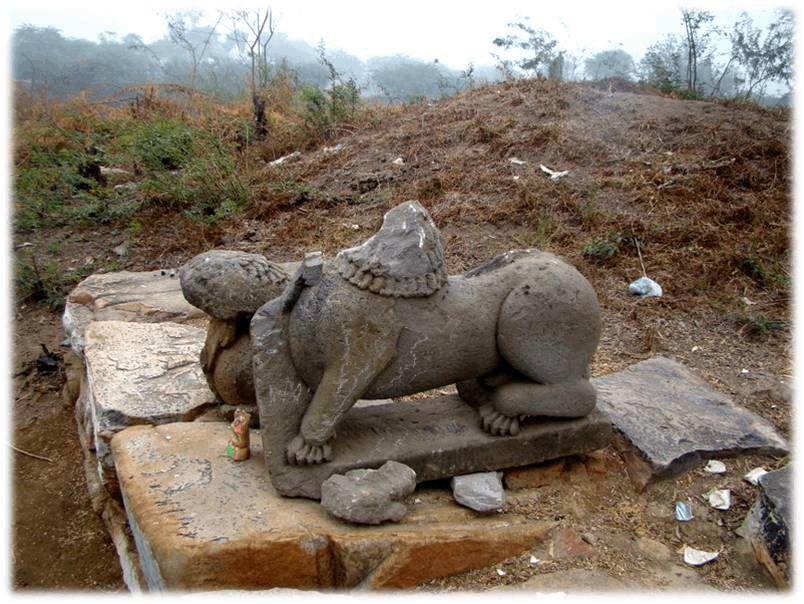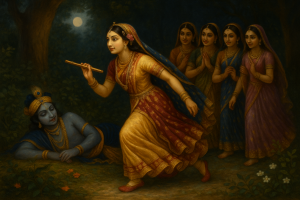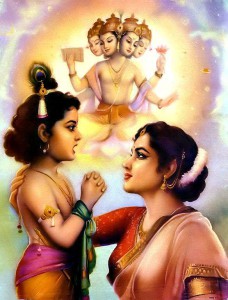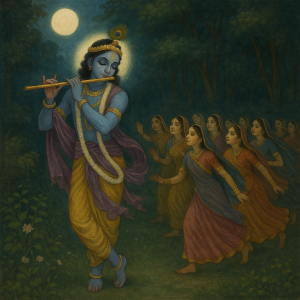One day, Krishna and Balaram were playing with Their friends, but it was time for them to come home to take Their lunch and mother Yashoda sent Rohini, “You go to get Krishna and Balaram”.
Rohini came and she said, “Krishna, Balaram, please come home. Your lunch is waiting for You. Nanda Maharaj is also waiting for You.”
But They were so busy playing, having so much fun with Their friends that They ignored mother Rohini.
So she went and told Yashodamayi that They will not come. So Yashodamayi came and she began to very strictly order Krishna, “You come back”.
But Krishna’s friends told Him “If You go we will not play with You tomorrow, because You will ruin our game if You go in the middle.”
So Krishna, afraid of being banned from the play, continued playing, and mother Yashoda was pleading with Krishna and chastising Krishna. But Krishna and Balaram just kept playing.
And finally mother Yashoda was thinking, “What should I do? He will be hungry. I cannot allow Krishna and Balaram to be hungry. It is not good for Their health.” So she began to think. Then she got an idea.
She said, “Krishna-Balaram, You better come right now, because the Hau-Bilau is coming”.
Krishna and Balaram said, “What is Hau-Bilau?”
She said, “He is coming. He is coming, lets go.”
They again asked, “What is this ‘Hau-Bilau’?”
Yashoda replied with a huff, “Hmm… ‘Hau-Bilau’ walks on four legs and has very, very fierce eyes and big, big mouth and sharp, sharp teeth and he eats little children, and he is coming”.
Then Krishna-Balaram looked at her and said, “We do not believe in “Hau-Bilaus”. There is no such thing.”
And then mother Yashoda, she looked behind Krishna and Balaram from where they were standing and she said, “Here he is, the “Hau-Bilau” has come ahhh!!!”
And then with big eyes she started running away as fast as possible.
And when Krishna and Balaram saw this they were afraid to even look back.
They immediately let out and scream and said, “Mother wait for us.”
They started running full speed ahead and mother Yashoda ran all the way back to Nanda Bhavan and Krishna and Balaram ran and ran as fast as they could.
They were afraid to even look back, and then They came into the house, and Yashodamayi had nice prasad ready for Them and They sat next to Nanda Maharaj.
And Krishna and Balaram were telling Nanda Maharaj, “You should have seen this Hau-Bilau. He had big fiery eyes, and long teeth and big mouth and fur all over him, but We escaped. Somehow or other We ran so fast, We got away.” and Nanda Maharaj was very happy.
So in this way mother Yashoda with her loving parental affection performed so many pastimes for the pleasure of Krishna and Balaram. It is also said, that after mother Yashoda saw that this pastime worked very good, she made these Murtis of Hau-Bilau.
And when Krishna and Balaram would be naughty, she would say, “Beware, I will take you to Hau-Bilau”. So they would become very nice. So, even the Supreme Personality of Godhead, Krishna and Balaram fear Hau-Bilau! This is the sweetness of the Leela of Shri Vraja Dham.
( Story narrated by His grace Deena Bandhu Prabhu and His holiness Radhanat Swami )
This delightful story of Krishna and Balaram illustrates the deep and loving relationship between the divine children and their mother, Yashoda, showcasing the universal and timeless themes of parental care, childhood innocence, and playful cunning. Here are several important lessons and reflections drawn from the narrative:
Lessons from the Story of Krishna, Balaram, and the Hau-Bilau
- Parental Love and Ingenuity: Yashoda’s actions reflect a parent’s deep love and concern for the well-being of their children. Her inventive method to get Krishna and Balaram back home underscores how parents often use creative strategies to guide their children’s behavior for their own good.
- Childhood Innocence and Playfulness: The story beautifully captures the innocence and playfulness of childhood. Krishna and Balaram, despite their divine nature, are depicted as relatable children, fully immersed in their games and companionships.
- The Power of Imagination in Teaching: Yashoda uses the imaginary figure of the Hau-Bilau to teach Krishna and Balaram a lesson about listening to their elders. This approach highlights how imagination can be a powerful tool in parenting and education to convey important messages in a way that resonates with young minds.
- Fear as a Motivator: The story shows how a controlled use of fear, not to traumatize but to guide behavior, can be effective. The imaginary Hau-Bilau becomes a recurring theme to encourage good behavior in Krishna and Balaram, illustrating how narratives and stories can be used to instill values and discipline in children.
- The Joy of Storytelling: The interaction between Krishna, Balaram, and Yashoda emphasizes the joy and bonding that storytelling fosters among family members. It serves not only as entertainment but also as a way to impart moral lessons and cultural values.
- Divine Play (Leela): Even the divine personalities like Krishna and Balaram engage in leelas that reflect human-like qualities and situations. These leelas are meant to bring the divine closer to the human experience, making the divine more accessible and relatable.
- Cultural Continuity: The creation of Murtis (statues) of the Hau-Bilau as a reminder of the story signifies how cultural narratives and practices are preserved and passed down through generations, reinforcing community and familial bonds.
Conclusion
The story of Krishna and Balaram being tricked by Yashoda using the tale of the Hau-Bilau is a charming and profound example of the ways in which divine stories from the Vedic tradition offer rich insights into human nature and relationships. It also reflects on how these narratives serve as tools for teaching, guidance, and entertainment, enriching the spiritual and cultural life of communities.
Sharing such stories within communities can enhance understanding and appreciation of spiritual teachings, thereby benefiting everyone by passing on wisdom and joy through delightful tales of the divine.
Hare Krishna, Hare Krishna, Krishna Krishna, Hare Hare, Hare Rama, Hare Rama, Rama Rama, Hare Hare.
May these stories inspire and guide all on the path of righteousness and joy.



